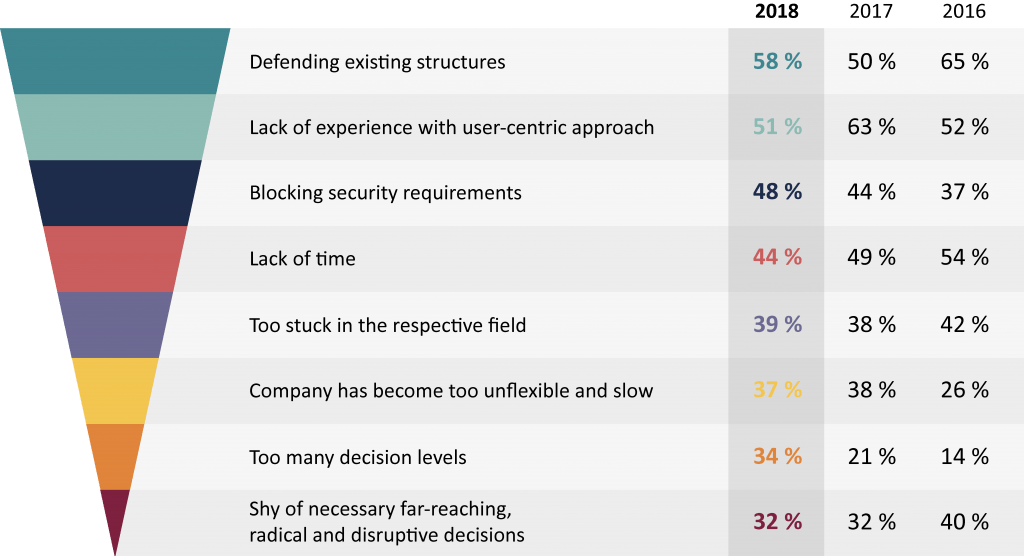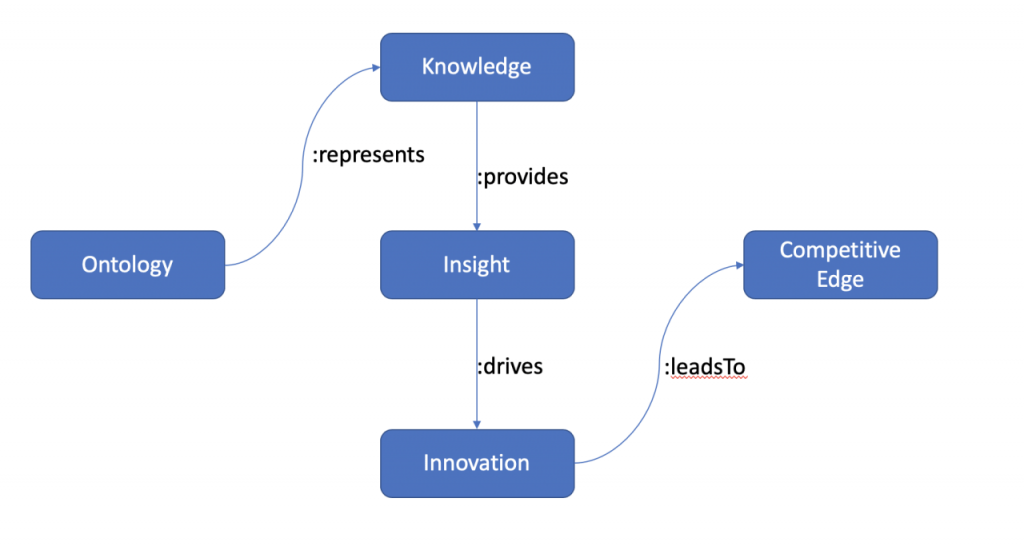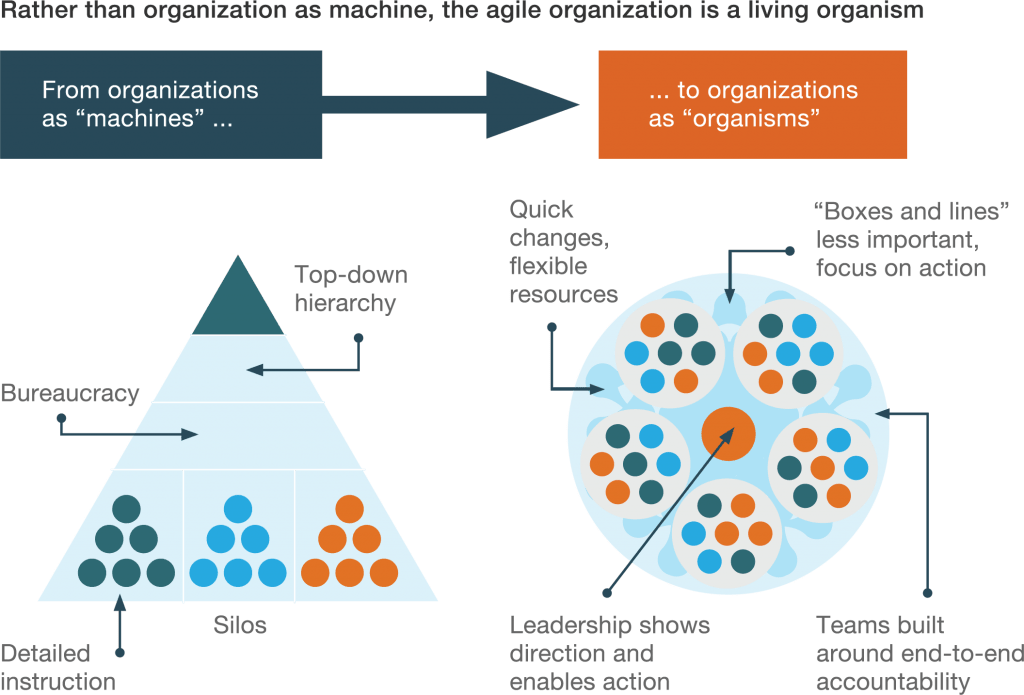
Digitization, change, transformation, work 4.0, and industry 4.0 – just a few current buzzwords that show the state of affairs in technological, economic, and cultural change. While this upheaval was not noticeable only a few years ago, it has now arrived in all branches of industry. Companies that did not recognize this trend at an early stage are currently facing significant challenges. A driver for the substantial progress is the widespread and fastened use of modern technologies such as distributed computing power, dynamically automated provisioning, scaling and administration of applications as well as the networking of our daily devices on the one hand and the worldwide penetration and usability of the Internet on the other. Technologies such as Artificial Intelligence, Digital Twins, or Smart Devices have become socially acceptable (cost-effective, efficient, simple, scalable) due to the points mentioned above.
Introduction
A successful digitalization, or the realization of one of the other keywords, does not take place by the mere introduction of new technology or modern hardware. No, successful digitization makes use of another field: the change in the working process, which is connected to the newly introduced technology, whether software or hardware. Because a shift in the world of work takes place through a transformation in the underlying processes and behaviors, both cornerstones (new technologies and adapted working practices) drive the mutual effect to shape the digital reform.
One of the current trends, both technological and process-related, is the increasing automation of workflows in the back office. The trend towards process automation makes it possible to increase productivity and increase efficiency. In particular, recurring, monotonous work activities of a process step can be standardized, automated, and performed error-free by process automation. They support and free the employee from routine tasks and thus release the potential for higher-value and creative work steps. If process automation is not only viewed from the perspective of automation but also coupled with modern working methods (e.g. communication systems, knowledge management, collaboration systems), further increases in efficiency can be achieved. Work can be innovatively defined and organized to make an increasing contribution to corporate strategy.
What you need
Have you taken a look at the status of digitalization – for example, here in Germany? There are some impressive numbers and facts. To 67% of German companies, digitalization means “only” the digitalization of their actual business model. And to 21% it means to develop new business models. Some other figures you can find in the etventure study “Digital Transformation 2019“. The critical outcome is that most companies think that “digitalization” is the use of new technology in their business models. The structural and organizational changes will only be adjusted to a limited extent. The reduction of hierarchies is the last but one measure. The hurdles to digital transformation in the company are shown in Figure 1.

Digital Transformation (based on the etventure study “Digital Transformation 2019”)
This is precisely where the most significant problem lies: digital transformation does not mean the use of anything with AI on a business plan, but the organizational and process-related adaptation of the company. This adaptation is the foundation for leveraging internal and external synergy, becoming faster, rising efficiency, and to gain competitive advantage by including modern technology.
Some weeks ago, I read the article “Did You Know What You Really Need is an Ontology?” by Mark Hall. It addresses the above statement by Illuminating digital transformation from another side. He claims that innovation comes from your enterprise data, which have to be linked and labeled. Therefore, an ontology and taxonomy is the primary basis driver for your digital transformation and leads to innovation. Figure 2 shows the framework Mark presented (“not quite a resource description framework”).

An enterprise ontology, together with a defined taxonomy, will link your data. It allows the use of your data treasure – by implementing your ideas or adding smart technologies to achieve a competitive edge.
What does it have to do the organizational and process change in your company? I would say everything – it goes hand in hand. Structuring your data in with an ontology and taxonomy breaks down your silos. When your data and its access are open, your organization will change to an organic structure. Figure 3 illustrates this transformation.

To bring both ideas together, just replace in figure 3 the term “organization” to “data”, and you will have the typical data storage of companies in their folder structures on the left side. In contrast, the right side represents an interlinked, labeled, and open data pool.
An idea to get, what you need: the Corporate Memory
For four months, I work now in the Private Equity (PE) business sector at THI Investments. It is a totally different area then my work at Volkswagen R&D and Commercial Vehicles before. But I enjoy this new one and have the opportunity to learn a lot. Above all, however, I can transfer my IT knowledge into a sector that has little IT affinity.
During my time at THI Investments was able to get to know and observe many typical PE working steps. A great experience to demonstrate new possibilities with requirement engineering approaches. What I have learned is that in the area of Private Equity, many different workflows have to be carried out before and during a purchase transaction. Although many of them are carried out repetitively today, they are not supported by a digital process chain. Figure 4 shows the general workflows of the typical PE phases “Origination”, “Transaction”, and “Governance”.

If these process steps are combined with the idea of a central database as ontology, which is based on a defined terminology, the following two questions arise in sum:
- For which work processes/process steps can digital aids be used sensibly? With the focus on making the processing of work steps more efficient, more transparent, standardized, etc.
- If the results of the process steps are available digitally, how can this knowledge be automatically integrated into future process flows in order to create synergies?
To build up the data ontology, it would be the goal to design and implement a procedure along the process chain for deal handling in order to integrate the potentials of process automation into the workflows. The term “Corporate Memory” can be introduced for such a digital process chain (or in other words, the ontology of the enterprise data). It represents the task of which is to network and store possible work artifacts from the exemplary work steps shown in figure 5.

In the first step of setting up the “Corporate Memory”, the individual work activities must be determined. Subsequently, the supporting application is to be selected, and the work activity digitized. Thus the single work step is standardized and easily repeatable. In further expansion stages, historical process automation data is to be automatically displayed to the user as “best practices” for new, related topics in order to benefit from the previous knowledge of the digital process chain.
The “Corporate Memory” is accordingly more than a pure “memory” for generated work artifacts. On the one hand, it consists of various interconnected applications in order to be able to map the specific work steps digitally. On the other hand, it consists of communication and collaboration systems. In summary, “Corporate Memory” can be divided into the following three main components:
- Digital, organic organizational structure (interlinked data storage and process structure)
- Networked applications for individual work steps (digital applications to obtain standardized work artifacts for each work step)
- Communication and collaboration system (to create an open work environment in which the focus is on networked working instead of just being networked and acting in a closed environment)
The “Corporate Memory”, the storage of data in an ontology and terminology, is a holistic approach to create a step-by-step link between the technological change (see article “Why Software Is Eating The World“, by Marc Andreessen) with the future cultural working values (see article “New Work New Culture“, by Frithjof Bergmann). Through a step-by-step introduction along with the process-related value chain, the “Corporate Memory” increases the efficiency and stores knowledge, on the one hand. And on the other hand, it creates understanding and transparency by an organic representation of data and culture, which leads to a natural organization.
Summary
In this post, we have introduced the term of “Corporate Memory” which represents the storage of data in an ontology and terminology manner.
I tried to combine the approach of changing the enterprise data handling with the future cultural working values. For me, both go hand in hand. Of course, it is a total change for companies to what they have done for years. Therefore such a change is always a process -which takes time, effort, and open-mindedness.
I am pleased to be part of THI Investments in accompanying and shaping this change. Over time, I will collect our concrete steps and measures in further blog posts. So, stay tuned when you are interested.
Literature
- Mark Hall – Did You Know What You Really Need is an Ontology?
- Andreas Schorn – Vernetzt sein ist nicht gleich vernetzt arbeiten
- etventure Studio Digitale Transformation 2019
- Mark Lambertz – Best practise vs. good practice vs. emergent practise
- Matt Turck – A Turbulent Year: The 2019 Data & AI Landscape
- Gümnther Wagner – Erfolgreiche Unternehmen sind der Zukunft voraus
- Christa Koenen – Klassische Hierarchien sind bei uns ein Auslaufmodell
- Marc Andreessen – Why Software Is Eating The World
- Frithjof Bergmann – New Work New Culture
- McKinsey – The five trademarks of agile organizations







[…] methods with selected digital tools. A part of it I have described in my previous blog post “The Digital Transformation – from the data-driven viewpoint“. I don’t want to go into the individual points again here, but try to become quite […]
[…] have changed completely. I am involved in issues of internal digitization (see the post “The Digital Transformation – from the data-driven viewpoint“) as well as in the search, evaluation, and acquisition of possible new portfolio companies. […]
[…] crisis and digitalization – the Damocles Sword hovering overall” and “The Digital Transformation – from the data-driven viewpoint“), which entities experience throughout their life cycle. Well, if the hypothesis is that […]